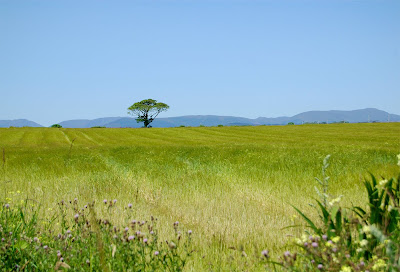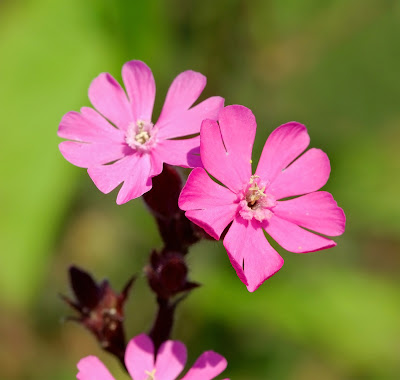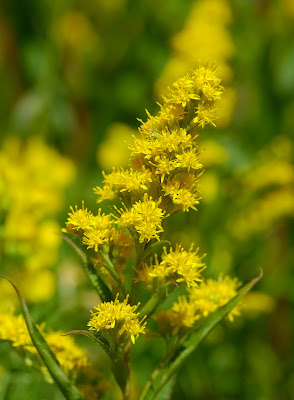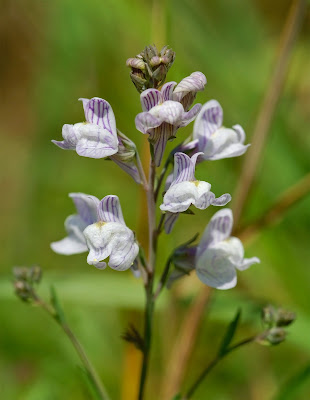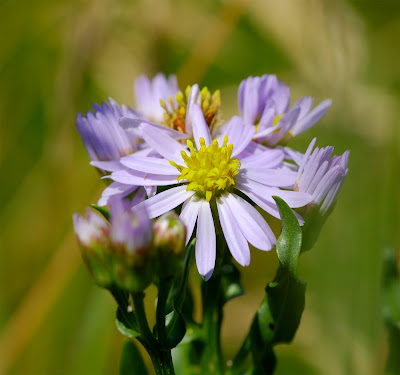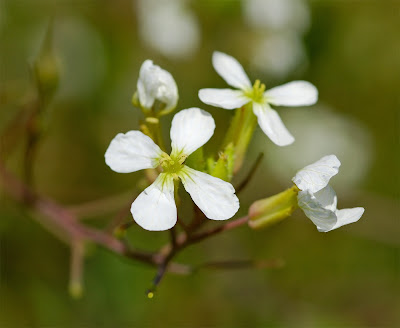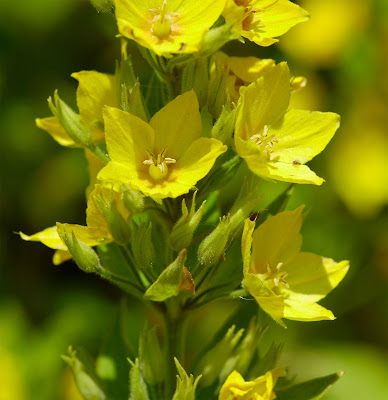On this visit to Kildonan I went rockpooling and focused primarily on photographing the denizens of the deep!
This blog entry is divided into shore sections, beginning in the wave-lapped rockpools of the lower shore and moving upwards past white-grained, inhospitable sand dunes until we reach the marshy coastal meadows at the foot of Kildonan's cliffs.
Kildonan is a very sheltered shore which means it has a high diversity of seaweeds, a very narrow/non-existant band of Verrucaria (a tarry black lichen of the upper shore) and very few barnacles or limpets (these can't compete with high densities of algae for footholds on rock surfaces and are effectively smothered).
Lower Shore:
Rockpools are scattered across the basaltic dykes: these are rich in marine invertebrates and trap many species of fish as the tide recedes (including Butterfish, Shannies, Tompot Blennies and Worm Pipefish).
Cuvie (Laminaria hyperborea) - a kelp - and the red seaweed (Ptilota gunneri) are found on the lowest part of this zone (scarcely exposed at low tide). Above these, there is a band of Toothed Wrack (Fucus serratus).
 |
| Shanny (Lipophrys pholis) |
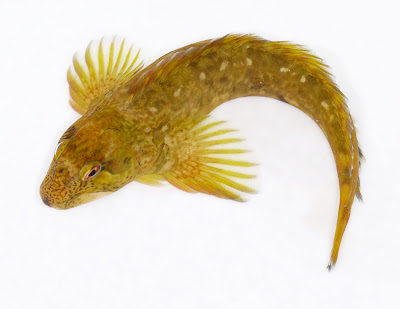 |
| Shanny (Lipophrys pholis) |
 |
| Shanny (Lipophrys pholis) |
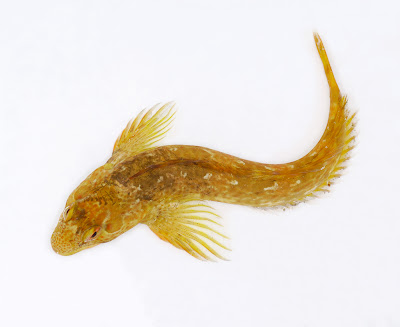 |
| Shanny (Lipophrys pholis) |
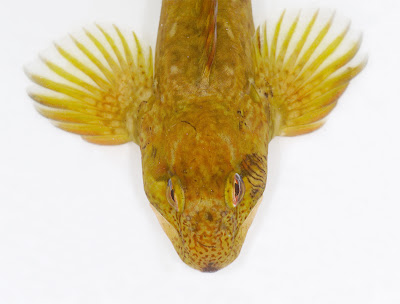 |
| Shanny (Lipophrys pholis) |
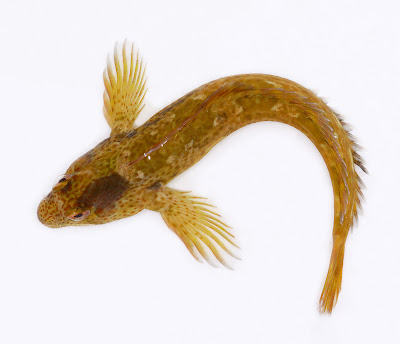 |
| Shanny (Lipophrys pholis) |
 |
| Shanny (Lipophrys pholis) |
The Shanny or Common Blenny is distinguishable from all other UK blennies by the absence of paired tentacles above the eyes. Full-grown individuals can reach a length of 16cm, but the specimens I caught today were about half that.
The large pectoral fins have broad rays and act as webbed feet, allowing the Shanny to hop between oxygen-deficient rock pools and crawl into damp rock crevices at low tide.
During the breeding season (April-August) the male Shanny changes colour: darkening to a blackish-brown with whitish lips. After the female has laid her eggs, the male will guard the eggs for 2 months until they hatch.
Its scientific name means 'fatty-eyebrowed scaleless-fish' (Lipo = fatty + ophrys = eyebrow: Greek and pholis = scale: Greek for a type of slimy, scaleless fish?).
 |
| Cuvie (Laminaria hyperborea) showing signs of grazing |
 |
| Cuvie (Laminaria hyperborea) |
Kelps are the 'trees of the ocean' and form dense 'underwater rainforests' or kelp beds to a depth of 30 metres: forming an extremely species-rich habitat.
Cuvie (Laminaria hyperborea) is one of the larger British kelps, growing to 3.5 metres in length and with a lifespan of around 20 years.
It is easily confused with its smaller relative Oarweed (Laminaria digitata), but Cuvie can be recognized by its easily snapped and rough-textured stipe (stem) unlike Oarweed (whose stipe is tough and slippery smooth). This allows colonization by epiphytes such as red seaweeds (Rhodophyta).
The visible kelp plant is actually one of two reproductive stages: the (diploid) sporophyte stage. The other stage, the microscopic (haploid) gametophyte, is either male or female.
Sperm from male gametophytes fertilizes eggs produced by female gametophytes and the resulting zygotes develop into kelp plants (sporophytes) which mature and release zoospores (which grow into 'invisible' male and female gametophytes).
 |
| Ptilota gunneri with bryozoans (grey) |
Ptilota gunneri is a stunning seaweed with blood-red, fern-like fronds and is an epiphyte on the stipes of Cuvie. See the greyish covering on the fronds? Those are mat-forming bryozoans.
 |
| Bryozoans on Ptilota gunneri |
Bryozoans or 'moss animals' (bryo = moss + zoon = animal: Greek) are sessile filter-feeding invertebrates of the Phylum Bryozoa. Most bryozoans form colonies composed of interdependent, genetically identical individuals called zooids (which are specialized for various functions such as feeding and defence).
 |
| Worm Pipefish (Nerophis lumbriciformis) |
 |
| Worm Pipefish (Nerophis lumbriciformis) |
 |
| Worm Pipefish (Nerophis lumbriciformis) |
 |
| Worm Pipefish (Nerophis lumbriciformis) |
 |
| Worm Pipefish (Nerophis lumbriciformis) |
 |
| Worm Pipefish (Nerophis lumbriciformis) dorsal fin |
 |
| Worm Pipefish (Nerophis lumbriciformis) |
 |
| Worm Pipefish (Nerophis lumbriciformis) |
Unlike the fiesty Shanny (which wriggles and nips when handled), the Worm Pipefish (Nerophis lumbriciformis) is a gentle, peaceable fish which slithers under rock ledges if disturbed and goes limp if caught. It's a master of camouflage, looking exactly like a strand of Thongweed or Bootlace Weed.
This is the smallest species of pipefish in the UK, reaching a maximum length of 15-17cm (again, my specimens were about half this). It can be easily identified by its short upturned snout, brown colouration and absence of all but the dorsal fin.
Like other members of the seahorse family, the female deposits her eggs on the ventral surface of the male who takes sole responsibility for their care until hatching.
The scientific name of the Worm Pipefish means 'worm-shaped wet-serpent' (Neros = wet + ophis = serpent: Greek, lumbrici = worm, from lumbricus + formis = shaped: Latin).
 |
| Gutweed (Ulva intestinalis?) |
Seaweeds of the genus Ulva vary greatly in form and are very difficult to identify. Those with tubular inflated fronds (gutweeds) were previously grouped in a seperate genus - Enteromorpha (literally, 'gut-shaped' in Greek). Species with flat, sheet-shaped fronds are known as 'sea lettuces'.
Enteromorphic Ulva seaweeds are found on all levels of the shore and can become abundant in areas with brackish water.
Ulva species are edible and can be rinsed and eaten raw in salads, cooked into soups or stir fried. In Japan, these seaweeds are known as 'green nori' or 'aonori' and are sold as dried sheets.
Sea Lettuce and Gutweed Recipes:
 |
| Toothed Wrack (Fucus serratus) ripe male with Common Flat Periwinkles (Littorina obtusata) |
Toothed Wrack (Fucus serratus) is very intolerant of desiccation and occupies a zone above kelp species but lower on the shore than other fucoids.
It is the only wrack with serrated edges to its fronds which have prominent midribs and no air bladders.
The Lifecycle of Fucoid Seaweeds:
Gamete (egg and sperm) production occurs in conceptacles, which are located in the (sometimes swollen) frond tips (known as receptacles). Instead of having a separate gametophyte stage like kelps, meiosis takes place within the conceptacles, before gametes are formed.
Fucoids can be hermaphrodites (monoecious) or, like Toothed Wrack, have separate male and female plants (dioecious). In this species, ripe male plants (pictured above) have an orange hue.
The eggs of many fucoids produce a species-specific chemoattractant to attract sperm (Toothed Wrack produces fucoserratin). Fertilized (diploid) zygotes develops into a new plants (sporophytes).
Middle Shore:
Here there is a zone of Bladder Wrack and Knotted Wrack (both moderately tolerant of desiccation).
 |
| Knotted Wrack (Ascophyllum nodosum) with Polysiphonia lanosa (bottom left) |
Knotted Wrack (Ascophyllum nodosum) has long strap-like fronds without midribs along which are arranged large, unpaired ovoid air bladders.
This is a slow-growing and long lived fucoid (up to 15 years) and has the ability to shed its outer epidermal layer (presumably to get rid of epiphytes).
Knotted Wrack is the preferred host for the red seaweed Polysiphonia lanosa, an obligate epiphyte which is thought to be partially parasitic, leeching nutrients through its hyphae.
 |
| Bladder Wrack (Fucus vesiculosus) |
 |
| Bladder Wrack (Fucus vesiculosus) |
 |
| Bladder Wrack (Fucus vesiculosus) |
Bladder Wrack (Fucus vesiculosus) can be identified by its paired air bladders and its smooth, flat dichotomously branched fronds with prominent midribs.
During the reproductive period the frond tips (receptacles) become puffy and swollen.
 |
| Common Flat Periwinkle (Littorina obtusata) |
Colourful little Common Flat Periwinkles (Littorina obtusata) were sprinkled over the fucoid fronds in gorgeous shades of lemon, tangerine, deep orange and olive green.
They can be instantly recognized by their bright colouration, their 'sanded smoothness' and by the 'tear-drop' shape formed by the shell aperture and anal sinus.
They graze mainly on Toothed, Knotted and Bladder Wracks.
 |
| Snakelocks Anemone (Anemonia viridis) brown colour morph |
Confined to the western coasts of Britain, the Snakelocks Anemone (Anemonia viridis) occurs in two colour forms: one has vivid green tentacles with pink tips and the other (pictured here) is a dull khaki brown.
Upper Shore:
Spiral Wrack forms a zone below Channeled Wrack on the high shore where there are big temperature fluctuations, few nutrients and only the most desiccation-resistant fucoids can survive.
 |
| Channeled Wrack (Pelvetia canaliculata) above, Spiral Wrack (Fucus spiralis) below |
Spiral Wrack (Fucus spiralis) lacks air bladders and has smooth-edged fronds which are twisted and have prominent midribs.
The hugely swollen reproductive receptacles (tips of the fronds) have a warty texture and have a slight keel (sterile edge of frond).
Unlike other Fucus, this species is hermaphroditic.
Channeled Wrack (Pelvetia canaliculata) is the most desiccation-resistant British fucoid, capable of surviving 8 days out of water and able to lose 90% of its water content. Its smooth-edged fronds have no air bladders or midribs and are folded longitudinally to form moisture-retentive channels.
During the reproductive phase, the 2-pronged receptacles become swollen and turn ochreous yellow.
This species is hermaphroditic - an adaptation to a short immersion period (limited reproductive opportunities).
 |
| Rocks |
Sand Dunes:
A mini-desert: few vascular plants and lichens can withstand this dry, unstable and nutrient-poor environment.
 |
| Yellow Flag (Iris pseudacorus) in dunes |
 |
| Bird footprints in sand (probably Hooded Crow's) |
 |
| Oxeye Daisies (Leucanthemum vulgare) with cliffs of raised shore behind |
 |
| Oxeye Daisy (Leucanthemum vulgare) |
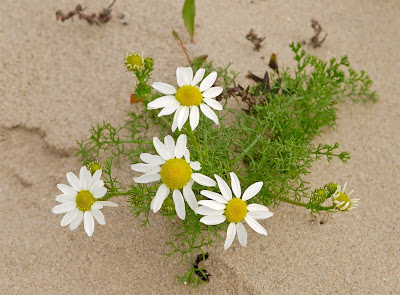 |
| Oxeye Daisies (Leucanthemum vulgare) |
 |
| Oxeye Daisies (Leucanthemum vulgare) |
Oxeye Daisies (Leucanthemum vulgare) prefer well-drained soils and can tolerate sandy habitats. Its scientific name is Latin for 'having-a-white-flower common' (Leucos = white + anthemum = having a flower, vulgare = common).
 |
| Lichens (Lecanora rupicola?) |
 |
| Ray's Knotgrass (Polygonum oxyspermum) |
 |
| Ray's Knotgrass (Polygonum oxyspermum) |
Ray's Knotgrass (Polygonum oxyspermum) is a locally distributed specialist of sand and shingle strandlines.
Key Identification Features:
- Glaucous (blue-green) leaves with slightly down-rolled margins.
- Glossy brown nut is longer than petals.
- Prostrate growth - creeps over sand.
 |
| Curled Dock (Rumex crispus) seeds |
Curled Dock (Rumex crispus) is another colonizer of disturbed ground and a very adaptable plant. Like other Rumex spp. it's safe to eat!
The leaves/stalks are sour (due to oxalic acid) but rich in iron and vitamins A and C. The dried seeds can be pickled or ground into flour.
Curled Dock Seed Recipes:
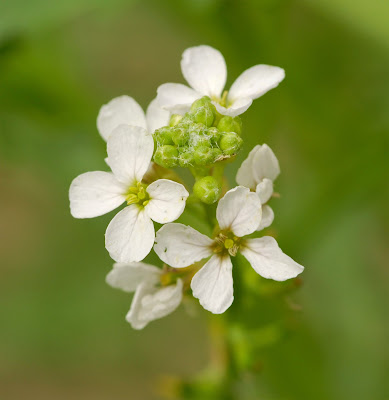 |
| Sea Rocket (Cakile maritima) |
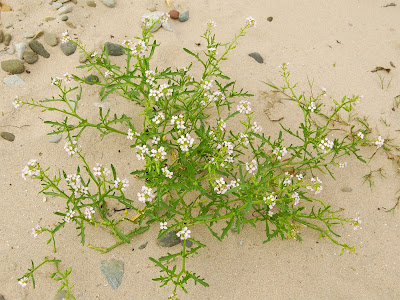 |
| Sea Rocket (Cakile maritima) |
 |
| Sea Rocket (Cakile maritima) |
Sea Rocket (Cakile maritima) is an edible, succulent-leaved crucifer which is specialized for sandy coastal habitats.
Key Identification Features:
- Conspicuously fleshy leaves.
- Lobed leaves are longer than broad.
- Seedpods have a 'waisted' hourglass shape.
 |
| Silverweed (Potentilla anserina) |
Marshland and Damp Meadow:
 |
| Water Mint (Mentha aquatica) |
 |
| Water Mint (Mentha aquatica) |
The commonest wild mint in Scotland, Water Mint (Mentha aquatica) has a strong scent which isn't as 'sweet' as cultivated varieties but it can be used in the same way in recipes. The essential oil extracted from this and other mints, is powerfully antibacterial and fungicidal.
 |
| Common Fleabane (Pulicaria dysenterica) |
 |
| Common Fleabane (Pulicaria dysenterica) |
Absent from most of Scotland, Common Fleabane (Pulicaria dysenterica) is an unmistakable yellow daisy with a large central disc and short, square-tipped petals.
It's very astringent and was traditionally used to treat dysentery (hence the species name dysenterica) and repel biting insects: as suggested by both its common and scientific names (pulicaria = of-fleas: Latin).
Other wildlife of interest seen during this walk:
- Otter - I saw something in the water, which I took for a seal. Later, it emerged from the water and bounded across the beach (all rippling muscle with a thick plank of a tail), disappearing into the wasteground adjacent to Kildonan Hotel.
- Oystercatchers - a few pairs.
- Hooded Crows.
- Sparrowhawk (male) - perched on rocky shore.
- 1 Redshank.
- Common Seals - the usual gang, happily snoozing!



